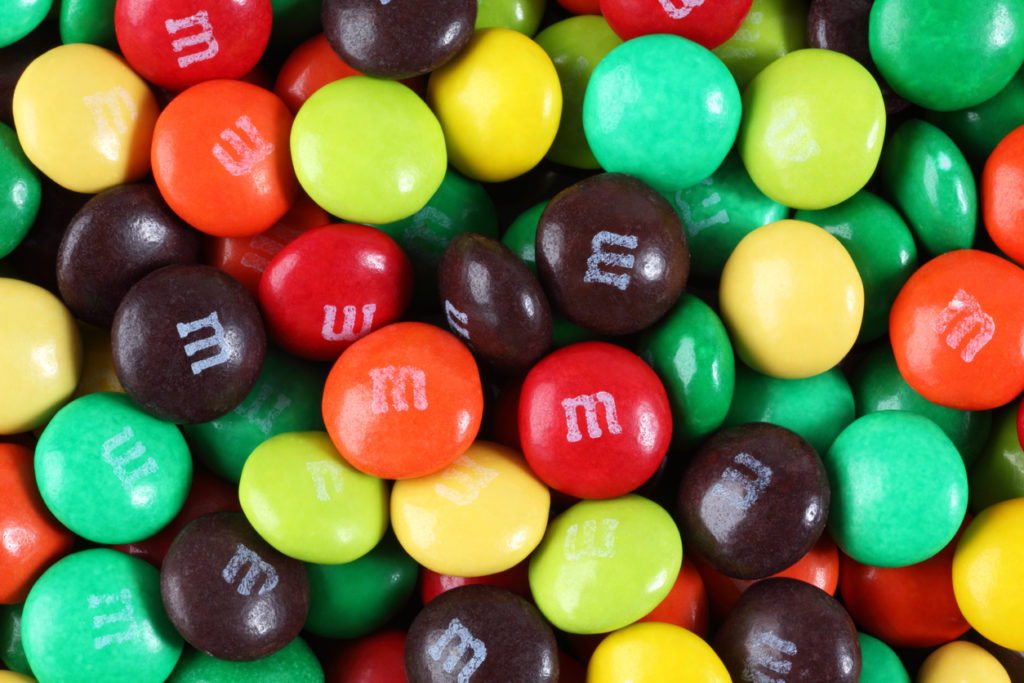Editor’s Note: Today’s post is by Nathan A. Stevenson. Nathan is Associate Professor in the College of Education, Health, and Human Services at Kent State University. He currently serves as Associate Editor for the journal Assessment for Effective Intervention.
As the story goes, a famous rock band used to insist their dressing room include a bowl of M&Ms with all of the brown M&Ms removed. The removal of brown M&Ms was not simply a quirky request, but a formal provision in the contract between the performers and venue management. This tale is often told to illustrate the gross excesses and eccentricities of rock musicians at the height of their fame and influence. The very premise of the story invokes a sense of privilege and power few people ever experience. Though there are true tales of performers requiring odd, expensive, or elaborate accommodations as a flex of their celebrity status, the story of the brown M&Ms is not one of them. The basic facts of this story are indeed true. The underlying rationale described above is not. This contract provision, belonging to the band Van Halen, served a much more practical purpose. More on that in a moment.

Some academic journals, and the editors of such journals have developed odd, and sometimes angering reputations for onerous, arcane, and seemingly arbitrary formatting requirements of manuscripts submitted for review. Rather than simply stick with the standard format of the chosen field of study (e.g., Publication Manual of the American Psychological Association, 7th Edition), some journals require manuscripts be formatted in a unique way. Examples include the use of non-standard fonts, alternate organization of section headings, uploading of tables and table captions as separate documents, and even specifying the order of content within a manuscript. And, just like Van Halen and the brown M&Ms, the stories and rationale behind such formatting requirements are as numerous as they are annoying, which is to say, very. Many scholars have experienced the annoyance, confusion, and disbelief of having otherwise high-quality work desk-rejected for failure to follow formatting requirements. These instances fuel perceptions of journal editors as sadistic, tyrannical figures driven purely by ego and schadenfreude. Fortunately, there is no more truth to these perceptions than to the assumed motivation behind removing brown M&Ms from the Van Halen dressing room.
As many journalists have previously reported, the contract clause to remove brown M&Ms had nothing to do with the band’s candy preferences. Van Halen’s legal and management team included this provision in performance contracts as a clever mechanism to quickly determine if venue management had thoroughly read the contract. As singer David Lee Roth noted in his autobiography, if the band or their representatives arrived to find a bowl of M&Ms sans brown ones, it was a clear indication that venue management had indeed read the contract. This gave the performers and their management team reasonable assurance that other, much more important provisions (e.g., critical safety and security procedures, technical specifications for lighting and sound, weight thresholds for staging, and electrical service) were being honored. The presence of brown M&Ms indicated exactly the opposite, kick-starting a necessary item-by-item check of the entire production. Essentially, the brown M&Ms were a shortcut to assessing compliance to critical components necessary to make the show happen smoothly and safely. Clever, eh?

In academic publishing we see the same mechanism at work in the form of specific manuscript format requirements. On the author’s side, non-standard formatting specifications are unnecessary hoops to be jumped through. On the editor’s side, compliance with formatting is a shortcut to evaluating the worthiness of a manuscript for peer review. At a time when academic journals are overrun with submissions, formatting is one way editors can efficiently filter manuscripts that warrant peer review from those that do not. If an author has taken the time to thoroughly read the submission guidelines and alter their manuscript to fit, the editor has some assurance the rest of the manuscript was crafted with care and attention to detail. Filtering by style compliance is also a task that could easily be assigned to the journal’s action editor who may or may not have expertise in the journal’s specific field of study. Of course, attention to formatting does not necessarily equate to quality science, or quality writing. Nevertheless, it is one [mostly] objective criteria editors can use as an initial gatekeeper to peer review.
It is easy to see the appeal of such a strategy. It is quite easy to explain, and easy to justify to authors whose manuscripts get rejected. Having a lot of desk rejected papers also keeps acceptance rates low, potentially adding to the prestige of a journal without overburdening reviewers or associate editors. However, this strategy is not without costs. One could easily argue that style should never trump substance when it comes to scientific information. And the quality of research within a publication is certainly more important than any journal metric (e.g., impact factor, acceptance rate). At least it should be. The public benefit of making scientific data visible and available is simply too important to be stifled by things like headings and fonts. Rejecting a paper merely because of formatting issues may keep valuable scientific data out of the public record and ultimately slow the pace of scientific discovery.
Likewise, the time spent formatting and reformatting an article is time that would be better spent on more direct research tasks like study design, data collection, and analysis. The time necessary to find, read, and format a lengthy paper [presuming one actually does these things] is often significant time that cannot be recouped. In the aggregate, that loss of time may have a considerable negative impact on ones’ career and the availability of important scientific data more broadly.
And yet the core function of a journal editor is to shepherd sound scientific research into public view while keeping out research that is erroneous or unsupported by credible data. It is a difficult job with an immense weight of responsibility to journal readership, the scientific community, and humanity. Filtering by explicitly defined formatting criteria can make that job much more manageable, enabling editors to devote greater attention to issues of scientific merit.
Unique style requirements are certainly not used by all journals. It would be a mischaracterization to suggest they are the only point of consideration in article screening. Some manner of specialized formatting requirements may also be attributed to technical requirements of publishers and the quirks of online manuscript submission systems.
The preceding discussion should not be taken as an endorsement or refutation of specialized formatting requirements nor their use in screening manuscripts for review. The point is merely to dispel a myth of academic publishing and enable better communication between authors, editors, and other stakeholders. Regardless of whether one loves or loathes such things it is in everyone’s best interest to have a clear understanding of the machinations of manuscript review. So, the next time one is asked to metaphorically remove the brown M&Ms, keep in mind it is likely just the editor, “Workin’ so hard, to make it easier, whoa”.
Discussion
15 Thoughts on "Guest Post — Of Brown M&M’s and Publishing in Academic Journals"
APA style is a great example, but not because it’s a standard citation style. Like Van Halen’s brown M&Ms, it has completely arbitrary rules that require pointless busywork. In prior versions (APA 6th) you had to check if a journal was paginated by issue. Only if a journal was paginated by issue, would you include the issue number. In APA 7th, you can now relax and include the issue number every time, but you now have to check which journals use article numbers instead of page numbers. If they use an article number, you write “Article ###”, if they use page numbers you write the page range. Neither rule can be automated easily with citation managers, so if you want to follow the style guide it’s back to tedious manual references. A complete waste of time.
Great analogy. As scientist whose authored papers going back to mid-David Lee Roth Van Halen years, I appreciate this explanation of journal rationale. I and co-authors have oft asked why there is not one format type, particularly with in a field of study. I will share this with my colleagues.
I note you reference DLR but link to a Sammy Hagar era (albeit one of the better ones) VH song. Hmmm.
I’ll show myself out.
In psychology the concept of omitting brown M&Ms is called CATCH TRIALS.
For us, it’s a case of authors vs. reviewers, even though they are the same people.
Basic formatting requirements, and yes even order of presentation, are instituted in order to provide the reviewers with easy to read, follow, and comment on manuscripts. And the authors who complain the loudest about their papers being returned to them for formatting corrections at submission* (usually the ones who have already made their own lives more difficult by insisting on working in LaTex) are the very reviewers who scream the loudest when they are asked to review a paper that is not prepared in 12-point type, double-spaced, with the figures clearly labeled and placed conveniently within the paper.
*I cannot understand why any editor would reject a paper for formatting; in our case the editors never even see papers that fail on formatting. Those are sent back at the quality control check for correction, not rejected.
I hear you. I’ve experienced this as well. Also, it may not be the editor themself but an action editor or editorial assistant that takes on the initial screening.
This gives the editors far too much credit in intention in my experience. The vast majority of editors I’ve worked with have no idea how or why their unique journal style has evolved, they only know that their readers ‘expect’ it and it’s ‘always been that way’ (usually it hasn’t; manuals have simply gone out of date or mistakes have been made and left uncorrected for years or even decades). Dogged insistence on esoteric formatting requirements keeps a field insular and elite (it also slows production and dissemination of research). It is not welcoming of new voices or perspectives and does not move a discipline forward. Format-neutral submission allows BOTH the author and editor to focus on the validity of results, the quality of research or argument, and passively assists in diversifying a journal’s author base. No brown M&Ms, please.
I would be quite surprised if most editors know the origin of the formatting choice for their respective journals. But you are certainly right that formatting and screening choices are not without consequence. I’m not sure what you mean by format-neutral submissions.
“Format-neutral submissions” is where a journal doesn’t require authors to format details like references or figure legends and such until the article is either likely to be accepted or accepted. Though there are some basic structural formatting requirements, authors are not made to sweat the details until it’s likely they’re going to get into the journal. This saves them time re-formatting the paper every time it gets rejected and needs to be submitted to another journal, and has been, at least in my experience, very popular with authors.
That’s interesting. Sounds like a really good idea in most cases. One exception though might be the formatting of things like graphs in single-case experimental research. The way data are displayed directly impacts the data analysis and interpretation of effects of a given intervention or experiment. In those case, the formatting is pretty consequential. Though despite its importance graph construction is not standardized in this type of research (but moving in that direction).
Yes, there are going to be some absolute formatting requirements needed — a Nature article for example has a different shape than that of many journals, and there should be field-specific conventions that must be followed. But using helvetica for labeling a figure or where one places the date in a reference listing is fairly inconsequential for the purposes of the review process, so why burden authors with all that work, particularly if they’re more likely than not to get rejected and have to re-do that same work elsewhere? Makes sense to me.
The other thing this post brought to mind is journals that limit article length and/or reference list length. Some assume this is due to the costs involved (even for an online-only journal, each page or reference still needs to by copyedited and typeset, incurring costs) and there’s some truth to that. But there’s also a motivation here of getting authors to be concise in their arguments No one wants to read a 100 page paper that could instead have been 5 pages long. Page limits and reference limits instill a need for discipline from writers, something that goes beyond just the cost savings offered.
Yes, without having a name for it or announcing it in any way, the various journals I’ve worked for have been using “format-neutral” since the early 2000s. It was just pretty obvious to not bother having authors fix minor formatting problems when their paper might be rejected anyway; these things could be requested later in the letter/message requesting a revision. Saved editorial office staff work on the front end too. If main components are missing or off though, those are requested right after submission.
This doesn’t seem to make much sense. If an author prepares a manuscript using the journal’s LaTeX template, it is automatically be formatted correctly. That is the point of having a template.
Unfortunately there’s huge variation across disciplines when it comes to this stuff. Many journals in don’t us LaTeX (at least not in the initial stages of submission), particularly in social sciences.
I know in the sciences there’s not a huge overlap between people who do research and write and submit articles and people who teach, but in the humanities, it’s the same people complaining about having to read author guidelines and complaining about their students not reading the syllabus.
Obviously it would be impolitic to do, but during the time I was the first admin person to review submissions for adhering to my journals’ guidelines, I always wished I could just respond, “It’s in the syllabus!”
We research-types are full of contradictions aren’t we! I love the comparison to the syllabus. It’s so on point.


